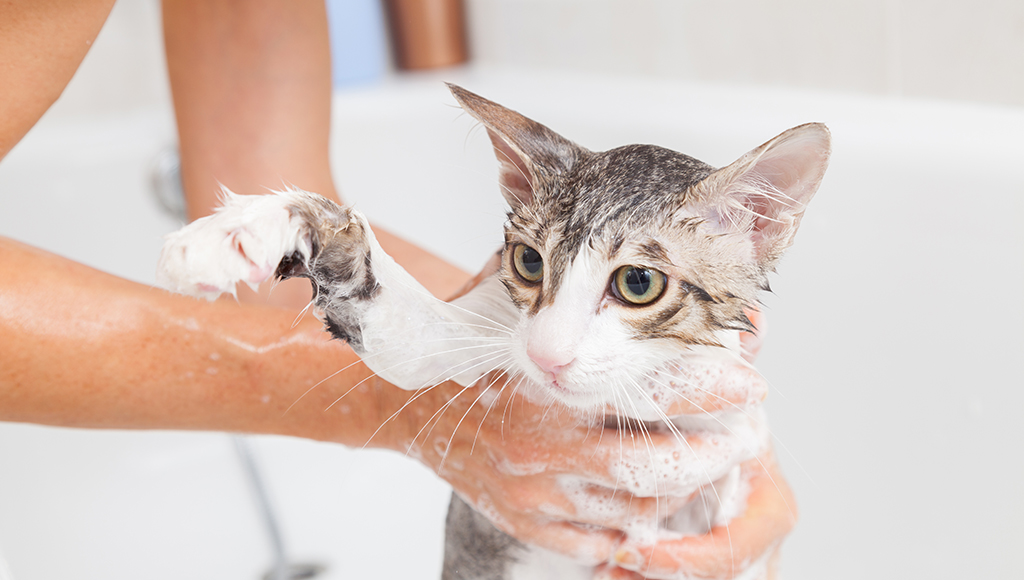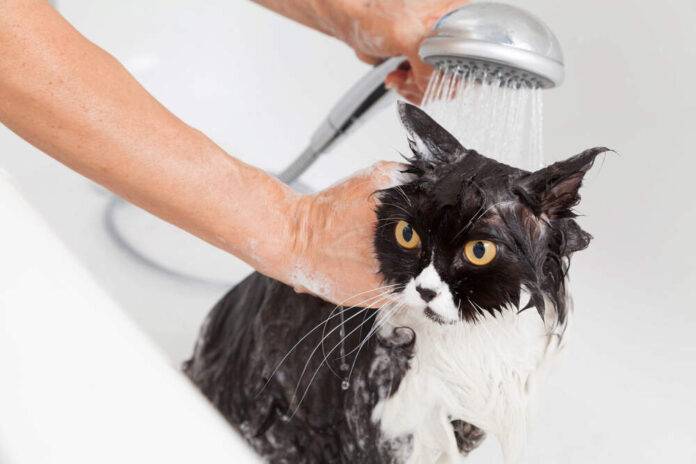Last Updated on February 15, 2024 by Fumipets
The Purr-fect Bath: Why and How You Should Bathe Your Cat
Bathing a cat may seem like a daunting task, often accompanied by visions of disgruntled felines and soaked humans. However, keeping your cat clean is an essential aspect of responsible pet ownership.
In this guide, we unravel the mysteries behind why bathing is beneficial for your cat’s well-being and offer practical tips on how to turn this potentially challenging endeavor into a stress-free experience. Discover the purr-fect reasons to bathe your cat and the gentle techniques to make bath time a harmonious ritual for both you and your feline friend.
How You Should Bathe Your Cat
Bathing a cat is possible, even though you wouldn’t put the words “cat” and “bath” together in the same phrase (unless it also contained the word “never!”). Some cats like it, and it’s occasionally necessary.
Why might you have to bathe your cat?
There aren’t many reasons to wash your cat since most cats are fairly meticulous in their grooming procedures in most settings. However, there are a few circumstances in which you may be forced to do so.
Ringworm— Rather than being a worm, this is a fungus. Medicated baths may be prescribed by your veterinarian depending on the severity of your cat’s condition and other considerations.
Flea infestations — Baths aren’t usually essential for flea-infested cats since most current flea medications kill fleas rapidly. Baths, on the other hand, may be useful and even required in severe infestations and in cats with flea allergies.
Need to remove something from their coat – examples include pyrethrin/permethrin flea killers (which may induce life-threatening convulsions), motor oil or gasoline, antifreeze, potpourri, tree sap, and others.
Obese or arthritic cats – They may be unable to groom themselves effectively and completely, necessitating baths on a regular basis to maintain their hair and skin healthy. Arthritic cats may even like the bath since the warm water and massage of lathering the shampoo may be soothing.
In between showers, grooming your cat is an excellent way to check for fleas, remove unwanted hair, and strengthen your relationship through brushing.

To wash your cat, make sure you have all of the necessary equipment and a strategy in place.
You’ll need some delectable goodies for your assistant to utilize to reward (and bribe) your cat.
Obtain a pitcher or detachable showerhead, as well as pet-specific shampoo and a large supply of towels.
Lay down a towel, non-slip bath mat, or even a cut-up yoga mat in your bathtub using your sink, laundry basket, or Rubbermaid® tub so your cat doesn’t stress out due to a slick surface.
Fill halfway with warm water (just a few inches) (not too hot).
Place and hold your cat there gently while your assistant wets your cat’s coat with the pitcher.
Wash your pet using a pet-specific shampoo (your doctor may recommend one, particularly if the wash is required for medical reasons, such as ringworm).
Using the pitcher or showerhead, thoroughly rinse the shampoo off (use a low flow rate so as not to scare your cat).
Using a succession of towels, thoroughly dry your cat. Use a blow dryer only if your cat is used to it… or if you don’t care about the skin on your arms and face.
Brushing your cat’s hair before washing will help avoid mats and tangles. The Furbliss silicone brushes are among the finest solutions for just about any cat, according to our research. They come in a number of sizes and styles, so no matter what size or quantity (or length) of hair your cat has, there’s one for them. Each brush features two sides for various tasks: a brush side for grooming and combing, and a finer side for de-shedding.
They’re gentle and simple to use since they’re made of silicone, and cats appreciate the soothing sensation of being brushed. They may also be sanitized in the dishwasher or cleaned under running water. This also means you can use them to wash and detangle your cat’s hair while they’re in the bath.

Before and After Bath Treats for Your Cat
Greenies are low-calorie snacks (just 1.25 calories per treat) that also help clean your cat’s teeth. They’re also quite popular among cats. Many cats like the Life Essentials freeze-dried chicken snacks, which are also low in calories and rich in protein. More low-calorie treat options may be found in our post Choosing the Best Cat Treats.
Our Favorite Supplies for Giving a Cat a Bath
The Best Tubs for Cats
In a huge bathtub, cats will feel more exposed and anxious. A sink is a simple solution that will help your cat feel safer while also being easier on your back since you won’t have to stoop over a tub.
A toddler bathtub can do if a sink isn’t feasible or you just don’t want to bathe your cat where you wash your dishes. (It probably goes without saying, but stay away from the inflatable tubs since cats have strong claws that may collapse an inflated bath quickly and permanently.) If you’re bathing your cat in a sink, a baby tub, or a normal tub, make sure they have plenty of traction by laying a towel on the bottom of the sink, baby tub, or regular tub.
Q&A: Navigating the World of Feline Baths
Why should I bathe my cat?
Bathing your cat helps maintain their coat and skin health, reduces shedding, and eliminates allergens. It also aids in preventing matting, removing debris, and can be crucial for cats with skin conditions or those who venture outdoors.
How often should I bathe my cat?
The frequency of cat baths depends on factors such as breed, activity level, and overall health. In general, most cats do well with a bath every 4-6 weeks. However, if your cat has specific skin issues or gets into messy situations, more frequent baths may be necessary.
How can I make the bathing experience less stressful for my cat?
Create a calm environment by choosing a quiet, warm room and using non-slip mats in the sink or tub. Gradually introduce your cat to water by allowing them to explore it on their terms. Use cat-friendly shampoos and reward positive behavior with treats, turning bath time into a positive association.
Are there specific breeds that require more frequent baths?
Certain breeds, such as those with long or dense coats like Persians or Maine Coons, may benefit from more regular baths to prevent matting. Breeds that are prone to skin conditions or allergies may also require more frequent bathing.
What if my cat hates water?
Many cats are averse to water, making the bathing process challenging. Start by acclimating your cat to water gradually, using positive reinforcement. Consider using waterless cat shampoos or wipes for spot cleaning if your cat is particularly resistant to full baths.


















